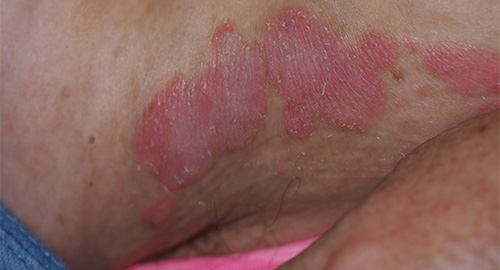Flexural psoriasis, including genital psoriasis
See also Napkin psoriasis.
Flexural psoriasis may affect the groin, gluteal cleft, axillae and submammary folds, with no sign of psoriasis elsewhere. When it affects the genital or perianal region alone it can be difficult to diagnose because it often has little scale. Genital psoriasis can present as nonspecific vulvitis. The main symptom is usually itching, but fissuring can cause pain. In females, genital psoriasis commonly affects the perianal area and natal cleft. In males, it mainly affects the scrotum and inguinal folds, but the penis may be involved as well. For a photo of flexural psoriasis, see here.
Consider and exclude other more common causes of lesions and rashes in the genital area (eg irritant dermatitis). A common cause of lesions and rashes in the genital area is infection (eg tinea, perianal streptococcal dermatitis). To exclude infection, consider taking a swab for microscopy and culture, and a skin scraping (to exclude tinea). If infection is identified, treat according to susceptibility results.

Photo sourced with permission from Dr Michelle McRae.
Flexural psoriasis can be difficult to treat, and some patients find topical therapy irritatingBeck, 2018Reynolds, 2020.
Avoid irritants and use a soap substitute. If the genital area is affected, advise patients on general measures as for genital dermatitis.
For initial therapy of flexural psoriasis in adults and children 4 months or older, use a topical corticosteroid. Use:
methylprednisolone aceponate 0.1% ointment or fatty ointment topically, once daily until skin is clear (may take several weeks), but for no longer than 2 weeks in a child wearing nappies. methylprednisolone aceponate methylprednisolone aceponate methylprednisolone aceponate
For a child who is still wearing nappies, add an anticandidal cream to the topical corticosteroid, (eg nystatin, an imidazole) as for irritant nappy rash.
When the initial flare has settled but some rash remains, add a tar preparation without salicylic acid because salicylic acid can sting. However, if the skin is excoriated or inflamed, do not use a tar preparation because even tar alone may sting. If a tar preparation is appropriate, use:
For a child who is still wearing nappies, LPC can be formulated in zinc cream.
If LPC is not tolerated, refer for dermatologist advice.
It is typical for flexural psoriasis to flare intermittently. To treat a flare, use a topical corticosteroid until the flare has resolved.
If topical therapy for flexural psoriasis is unsuccessful, refer for dermatologist advice. Phototherapy can be effective.
For practical information on using topical corticosteroids and tar preparations in psoriasis, see Topical drug treatment for psoriasis in primary care.
